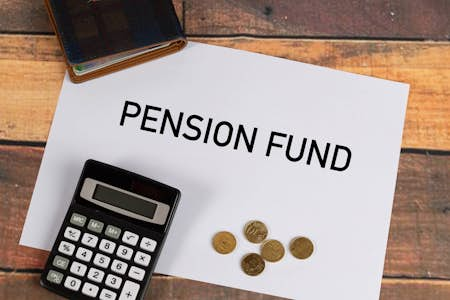Pensions are funds built throughout our working life, designed to provide for us in retirement.
One of the main aims of a pension is to beat inflation. By simply saving money in your bank account or holding it as cash, your money will depreciate over time.
Pensions can beat inflation through a combination of tax relief and investments.
In contrast to long-term savings, pensions come with the benefit of tax relief and also provide you with an opportunity to invest for the future - to beat inflation and grow your money.
Maximise your retirement fund with our panel of pension providers. Click on your chosen provider to get started!
The different types of pension
There are three main types of pensions in the UK, including two subtypes.
The main types are:
- State Pension - paid by the government based on National Insurance contributions
- Workplace pensions - either defined benefit or defined contribution pensions
- Personal, individual or private pensions - a type of defined contribution scheme pension
State Pensions are their own category - we can put those to one side for now.
- Workplace pensions are typically defined contribution pension schemes, in the private sector at least - these involve investments into pension funds.
- Personal pensions, also known as individual or private pensions, are always defined contribution pension schemes - these also involve investments into pension funds.
- In the public sector, workplace pensions are usually defined benefit pensions schemes, which are salary-based. This is only a rule of thumb - there are still plenty of companies in the private sector that still pay defined benefit pensions.
How do workplace pensions work?
Your employer is legally obliged to set up a workplace pension on your behalf, known as auto-enrolment.
As part of your workplace pension, your employer must make a mandatory contribution. You can also make contributions from your salary, and in many cases, employers will match your contribution to a certain level.
You can track down workplace pensions using the government’s Find a Pension tool.
Your employer will have a dedicated pension provider, such as NEST, that manages your pension. The level of control, if any, you have over how your workplace pension is invested will depend on your provider.
How do personal pensions work?
Personal pensions, also known as individual or private pensions, offer the most freedom and control.
These are designed for:
- People who may want another pension in addition to their workplace pension.
- People who opt-out of their workplace pension and wish to make their own savings.
- Self-employed people who won't have a workplace pension.
Personal pensions have skyrocketed in popularity lately, primarily because of the rise of self-employment and peoples' desire to have greater control over their investments.
Personal pensions vary massively based on their risk profile, investment types and other unique features. Often, you’ll be able to pick from a selection of curated funds selected by financial professionals specifically for investments.
There are personal pensions that invest in green technology, clean energy and other ethical stocks.
How does the State Pension work?
When we work, we accrue pension credits via National Insurance contributions.
You pay mandatory National Insurance contributions if:
- You are an employee earning above £184 a week.
- You are self-employed and making a profit of £6,515 or more a year.
- If you don’t earn enough to pay National Insurance, you can voluntarily pay National Insurance to qualify for pension credits.
These contributions help qualify you for a State Pension, which you will get after ten qualifying years (albeit a minimal amount).
If you have 35 qualifying years of contributions, you’ll typically get the full State Pension.
The State Pension won’t usually pay enough for you to live comfortably in retirement but will act as a helpful supplement to your workplace or private pension.
Pension tax relief explained
The concept of pension tax relief is confusing to many.
The motivation behind pension tax relief is that the government gives you a bonus for saving for the future.
Some or all of the money you would otherwise pay as tax goes into your pension.
You get tax relief at the highest rate of income tax you pay:
- Basic-rate taxpayers can claim 20% pension tax relief.
- Higher-rate taxpayers can claim 40% pension tax relief.
- Additional-rate taxpayers can claim 45% pension tax relief.
- Note that there are different rules in Scotland.
You’ll get tax relief on pension contributions up to 100% of your earnings, capped at £40,000.
Think of it like this:
If you were to pay £100 into your pension, it will actually only cost you £80. You would be paying 20% tax on that £100 if you were keeping it - that £100 is only £80 in your pocket after paying income tax.
Instead of paying that £20 to the government as income tax, they pay it into your pension pot as a bonus.
So, you only need to pay £80 to receive £100 in your pension pot (if you’re on the standard income tax rate).
Tax relief gets more complicated for the highest earners and comes in the form of tapered tax relief. If your adjusted income (your income plus pension contributions) exceeds £240,000, your tax relief will be tapered off at a varying ratio.
Here is the current tapered tax relief allowance as of 2021:
| Earnings | New annual allowance |
| Up to £240,000 | £40,000 |
| £250,000 | £35,000 |
| £260,000 | £30,000 |
| £270,000 | £25,000 |
| £280,000 | £20,000 |
| £290,000 | £15,000 |
| £300,000 | £10,000 |
| £310,000 | £5,000 |
| £312,000 | £4,000 |
How do pensions work?
Pensions provide us with a means to save for when we reach retirement age.
The main three types of pension are:
- Workplace pensions.
- The State pension.
- Private pensions - also known as personal or individual pensions.
Workplace or private pensions may be:
- Defined contribution pension schemes - investment orientated.
- Defined benefit pension schemes - salary based.
There are many options around private pensions, but you may still have varying options of pension funds when it comes to a workplace pension.
Defined benefit workplace pensions are usually more rigid in structure but potentially more secure.







